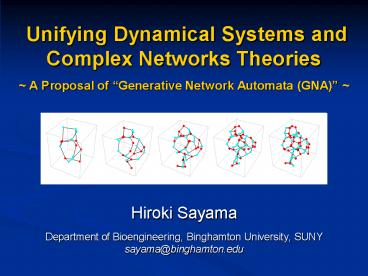Unifying Dynamical Systems and Complex Networks Theories ~ A Proposal of
1 / 13
Title:
Unifying Dynamical Systems and Complex Networks Theories ~ A Proposal of
Description:
Department of Bioengineering, Binghamton University, SUNY. sayama_at_binghamton.edu. 2 ... Describe statistical properties of complex networks resulting from exogenous ... –
Number of Views:53
Avg rating:3.0/5.0
Title: Unifying Dynamical Systems and Complex Networks Theories ~ A Proposal of
1
Unifying Dynamical Systems and Complex Networks
Theories A Proposal of Generative Network
Automata (GNA)
- Hiroki Sayama
- Department of Bioengineering, Binghamton
University, SUNY - sayama_at_binghamton.edu
2
Whats Been Used in Complex Systems Research (1)
- Nonlinear dynamical systems
- Ordinary / partial differential equations
- Iterative maps
- Artificial neural networks
- Random Boolean networks
- Cellular automata
- Describe dynamics in a phase space with fixed
dimensions no topological changes
3
Whats Been Used in Complex Systems Research (2)
- Complex network growth models
- Recent advances of network science
- Small-world / scale-free networks
- Describe statistical properties of complex
networks resulting from exogenous topological
transformations - Limited attention paid to dynamical state
transitions no autonomous topological
transformations
4
Whats Missing in Them?
- Many real-world complex systems change their
states and topologies simultaneously due to their
own dynamical rules
System Nodes Edges States of nodes Topological changes
Organism Cells Intercellular communication channels Gene/protein activities Fission and death of cells during development
Ecological community Species Interspecific relationships Population Speciation, invasion, extinction of species
Human society Individual Conversations, social relation-ships Social, professional, economical, political, cultural statuses Changes in social relationships, entry and withdrawal of individuals
Communica-tion network Terminals, hubs Cables, wireless connections Information stored and transacted Addition and removal of terminal or hub nodes
5
Objective
- To develop a novel modeling framework Generative
Network Automata (GNA) that can effectively
describe the dynamics of a broader class of
complex systems whose states and topologies both
keep changing due to their own dynamical rules - This is uniquely achieved by integrating
- Nonlinear dynamical systems (automata)
- Complex network growth models
- Generative graph grammars
6
Configuration
- Defined as a directed graph where each node has a
state si ? S - Config. at time t is given by ltVt, Ct, Ltgt
- Vt A set of nodes
- Ct Vt ? S States of nodes
- Lt Vt ? Vt Ordered lists of neighbors
7
Dynamics
- Evolution of GNA is described as a repetitive
rewriting process - Defined by ltE, R, Igt
- E Extraction mechanism
- Selects part of GNA (subGNA) for rewriting
- R Replacement mechanism
- Produces a new subGNA as a replacement
- Specifies how to embed it into the rest of the
GNA - I Initial configuration
8
A Rewriting Event
E
R
(a) E selects part of the GNA. (b) R produces a
new subGNA as a replacement of the old subGNA and
also specifies the correspondence of nodes
between old and new subGNAs. The bridge edges
that used to exist between the old subGNA and the
rest of the GNA remain unconnected and open. (c)
The new subGNA is embedded into the rest of the
GNA according to the node correspondence. (d) The
updated configuration after this rewriting event.
9
Handling Multiple Rewritings
- Rewriting is typically defined as asynchronous
processes - Synchronous scheme may cause conflicts between
multiple rewriting events - GNA may be updated synchronously if
- rewriting rules are all context-free (i.e., E
always selects just one node), or - GNA is used to simulate conventional dynamical
networks, etc.
10
Simulation Software
- Preliminary simulator implemented as an add-on
package in Wolfram Research Mathematica - Still under development but available upon
request - Development of full-scale simulation software
planned
11
Generality of GNA
- GNA can uniformly represent in ltE, R, Igt
- Conventional dynamical systems models
- If R always conserves local network topologies
and modifies states of nodes only - E.g. CA, ANNs, RBNs
- Complex network growth models
- If R causes no change in local states of nodes
and modifies topologies of networks only - E.g. small-world, scale-free networks
12
Summary
- Proposed GNA, a novel modeling framework of
complex systems - Describes both state transitions and topology
transformations via repetitive rewritings - Provides a common format of modeling applicable
to diverse fields - Demonstrated its generality and explored possible
dynamics in its simplest form - Poster/preprints available
13
Whats Next
- Develop appropriate metrics for local rewriting
rules, resulting global networks, and their
quantitative relationships - Evaluate the designability/controllability of GNA
evolution - Develop efficient simulation/analysis tools
- Apply GNA to real-world problems
- Modeling morphogenesis, social dynamics,
self-organization of collective intelligence































